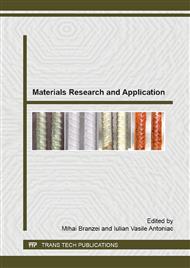[1]
R. Kuziak, R. Kawalla, S. Waengler, Advanced high strength steels for automotive industry, Archieves of Civil and Mechanical Engineering, vol VIII, no. 2, 2008, 103-117.
DOI: 10.1016/s1644-9665(12)60197-6
Google Scholar
[2]
D.K. Matlock, J. G. Speer, E. De Moor, P. L. Gibbs, Recent developments in advanced high strength sheet steels for automotive applications: An overview, Jestech, 15(1), (2012), 1-12.
Google Scholar
[3]
D.K. Matlock, J.G. Speer, Processing opportunities for new advanced high-strength sheet steels, Materials and Manufacturing Processes, 25 (2013), 7-13.
DOI: 10.1080/10426910903158272
Google Scholar
[4]
T. Kulik, Nanocrystallization of metallic glasses, Journal of Non-Crystalline Solids, 287 (2001), 145-161.
DOI: 10.1016/s0022-3093(01)00627-5
Google Scholar
[5]
A. Inoue, Stabilization of metallic supercooled liquid and bulk amorphous alloys, Acta Materialia, 48 (2000), 279-306.
DOI: 10.1016/s1359-6454(99)00300-6
Google Scholar
[6]
A. Inoue, A. Takeuchi, B. Shen, Formation and functional properties of Fe-based bulk glassy alloys, Materials Transactions, Vol. 42, No. 6 (2001), 970-978.
DOI: 10.2320/matertrans.42.970
Google Scholar
[7]
A. Takeuchi, A. Inoue, Calculation of crystallization temperature of multicomponent metallic glasses, Materials Transactions, Vol. 43, No. 9 (2002), 2275-2285.
DOI: 10.2320/matertrans.43.2275
Google Scholar
[8]
A Masood, Functional metallic glasses, Doctoral thesis, 2012, 5-16.
Google Scholar
[9]
T. Egami, Glass transition and viscosity in metallic glasses and liquids, Journal of Alloys and Compounds, 434-435, 2007, 110 -114.
DOI: 10.1016/j.jallcom.2006.08.252
Google Scholar
[10]
W. Pilarczyk, R. Nowosielski, A. Januszka, Structure and properties of Fe-Cr-No-C bulk metallic glasses obtained by die casting method, Journal of Achievements in Materials and Manufacturing Engineering, Vol. 42, Issues 1-2, 2010, 81-87.
Google Scholar
[11]
K.A. Lee, Y.C. Kim, J.H. Kim, C.S. Lee, J. Namkung, M. C. Kim, Mechanical properties of Fe-Ni-Cr-Si-B bulk glassy alloy, Materials Science and Engineering A 449-451 (2007) 181-184.
DOI: 10.1016/j.msea.2006.02.304
Google Scholar
[12]
B. Ramakrishna Rao, M. Srinivas, A.K. Shah, A.S. Gandhi, B.S. Murty, A new thermodynamic parameter to predict glass forming ability in iron based multi-component systems containing zirconium, Intermetallics 35 (2013), 73-81.
DOI: 10.1016/j.intermet.2012.11.020
Google Scholar


